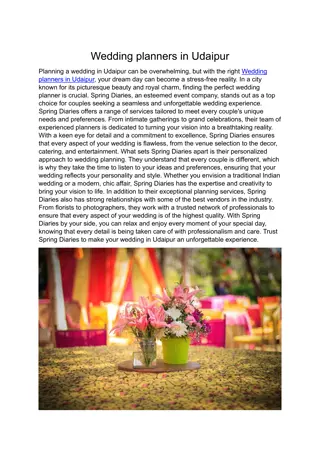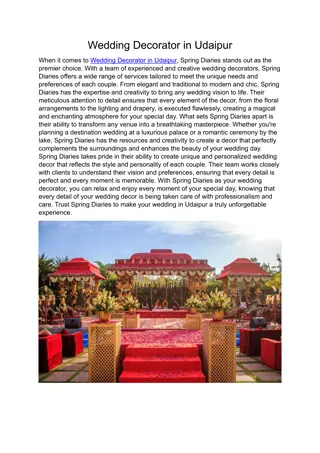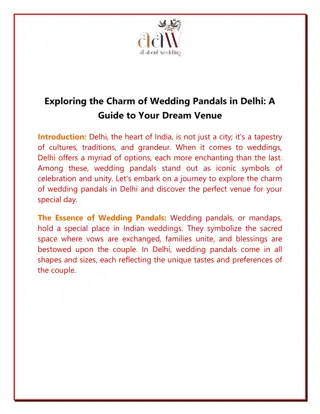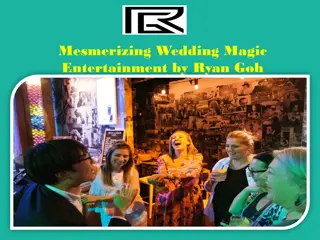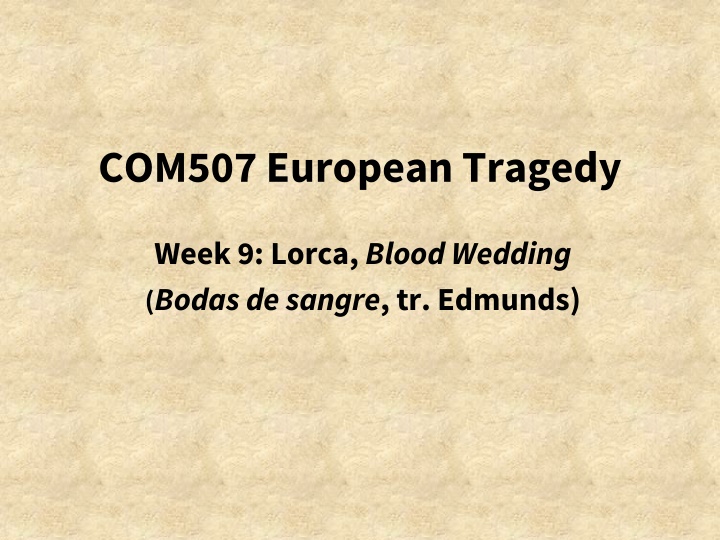
Exploring Lorca's Blood Wedding: Tragedy, Life Basis & Career
Delve into Federico García Lorca's iconic play, Blood Wedding, as we uncover the real-life inspiration behind it, Lorca's career, and the 20th-century perspectives on tragedy. Explore Lorca's privileged upbringing, poetic works, and the controversial circumstances surrounding his tragic end.
Download Presentation

Please find below an Image/Link to download the presentation.
The content on the website is provided AS IS for your information and personal use only. It may not be sold, licensed, or shared on other websites without obtaining consent from the author. If you encounter any issues during the download, it is possible that the publisher has removed the file from their server.
You are allowed to download the files provided on this website for personal or commercial use, subject to the condition that they are used lawfully. All files are the property of their respective owners.
The content on the website is provided AS IS for your information and personal use only. It may not be sold, licensed, or shared on other websites without obtaining consent from the author.
E N D
Presentation Transcript
COM507 European Tragedy Week 9: Lorca, Blood Wedding (Bodas de sangre, tr. Edmunds)
Plan for the session Lorca s career The real-life basis for Blood Wedding Some 20th-century perspectives on tragedy Blood Weddingand tragedy: a linear survey 1. 2. 3. 4.
Federico Garca Lorca (1898-1936) A privileged upbringing as the son of a major landowner in Andaluc a Mainly wrote poems and plays; first published book 1918 A friend of various major artistic figures (e.g. Bu uel, Dal ) while a student Major poetry collections include Book of Gypsy Ballads(Romancero gitano, 1928) and Poet in New York (Poeta enNueva York, 1929-30; first publ. outside Spain in 1940) Poetry was quite experimental, and alluded to his homosexuality Federico Garc a Lorca, Huerta de San Vicente, Granada, 1932 (anonymous photograph; public domain)
Federico Garca Lorca (ctd) 1932-4 Directed La Barraca [The Shack], a travelling student theatre company performing classical Spanish plays in rural areas (funded by the Ministry of Education of the Second Republic) Reflects the way his work embraces both high and popular culture Blood Weddingfirst performed 1933; it was Lorca s most famous and commercially successful play during his lifetime Forms part of a rural trilogy with Yerma (1934)and The House of Bernarda Alba (1936; posthumously published); these remain his best known plays Arrested and shot by a Nationalist group shortly after the beginning of the Spanish Civil War Widely thought to have been killed because of his sexuality and/or Republican sympathies, though a personal dispute has also been suggested His remains have never been identified; his work was banned by the Franco regime until 1953, and censored thereafter
The real-life basis for Blood Wedding Lorca freely acknowledged that his plot was based on a 1928 episode from his native region, reported in the national press Francisca (Paca) Ca adas was due to marry Casimiro P rez, but eloped with her cousin Francisco (Paco) Montes Paco was shot by Casimiro s brother Jos , who was jailed for fifteen years but released after eight; Paca lived until 1987 The plot of Blood Wedding is somewhat different: most obviously, the Bridegroom and Leonardo kill each other In any case, neither the historical event nor the author s life explain how the play works In many ways, differences from the event are more helpful for our understanding
The real-life basis for Blood Wedding If it isn t a criminal case or an aspect of Lorca s life, what is it? It can be useful to look at performances, regardless of language: A 2013 production by a Spanish drama academy, the Escuela Superior de Arte Dram tico de Castilla y Le n, televised by Castilla y Le n Televisi n: opening to 2:09 Musical introduction doesn t reflect Lorca s script: effects? Evokes a world that is clearly different; not too close to audience s lives A world that isn t subject to ordinary social processes: criminal justice, pragmatic compromises, etc. Elemental forces and absolute values; highly apt for tragedy cf. Hegelian pathos, passion in Racine Note also the half-masks worn by several actors: a nod to the performance tradition of Greek tragedy
Some 20C perspectives on tragedy Partly influenced by important 19C views on Greek tragedy: Hegel: tragedy as essentially political (cf. Antigone) Friedrich Nietzsche, The Birth of Tragedy (1872): saw the work of Aeschylus and Sophocles as combining two competing but complementary impulses in Greek culture the Apollonian and the Dionysian (Nietzsche, The Birth of Tragedy, tr. Douglas Smith [Oxford University Press, 2000], p. xvi) Apollo: rationality, moderation, individual moral subjects, visual arts Dionysus: flux, excess, dissolution of identities, music (cf. Antigone lecture)
Some 20C perspectives on tragedy 2 D. D. Raphael, The Paradox of Tragedy (1960) Rejects Aristotle s conception of tragedy: catharsis seen as nonsensical hamartia seen as unnecessary to tragic plots Both these critiques can be contested: catharsis isn t essential for Aristotle; just a benefit for emotionally unstable audience members hamartia is misunderstood as flaw
Some 20C perspectives on tragedy 3 George Steiner, The Death of Tragedy (1961) very influential Sees tragedy as impossible after the Enlightenment, which brought an end to absolute values: the decline of tragedy is inseparably related to the decline of the organic world view and of its attendant context of mythological, symbolic, and ritual reference. Steiner, The Death of Tragedy (London: Faber & Faber, 1961), p. 292 Hence for Steiner, Ibsen isn t tragic (he doesn t mention Lorca): In tragedy, there are no temporal remedies. The point cannot be stressed too often. Tragedy speaks not of secular dilemmas which may be resolved by rational innovation, but of the unaltering bias toward inhumanity and destruction in the drift of the world. But in these plays of Ibsen s radical period, such is not the issue. There are specific remedies to the disasters which befall the characters, and it is Ibsen s purpose to make us see these remedies and being them about. A Doll s House and Ghosts are founded on the belief that society can move toward a sane, adult conception of sexual life and that woman can and must be raised to the dignity of man. (Steiner, 1961, p. 291)
Blood Wedding and tragedy How can the play be seen as reflecting its designation as Tragedy (p. 1)? In brief: aspects reflect Steiner s assumptions about tragedy though we may not need Steiner if we focus on pity and fear What follows is relatively linear: suitable for this less obvious case of tragedy An important sign in the cast list: Bridegroom (Novio), Mother (Madre), Neighbour (Vecina), Wife (Mujer), Bride (Novia) Names can be seen as archetypal: function within a relational unit, i.e. as part of something much larger (eternal?) Does this cut us loose from any particular social setting, and focus on fundamental relationships that are independent of time and place? The exception is Leonardo, though even his name can be linked to two common Spanish words Fitting a passionate and socially irresponsible character We might be tempted to see his surname as ironic Hence names already give us an idea of characters roles and these are the only roles they have i.e. they don t do anything else; they aren t involved with what we might call day-to-day life, but exist only within the tragic plot
Cf. Steiner on verse in tragedy: [V]erse sets a barrier between the tragic action and the audience. Even where there is no longer a chorus it creates that necessary sense of distance and strangeness [ ]. The difference of languages between the stage and the pit alters the perspective and gives to the characters and their actions a special magnitude. [ ] We cannot leap into their skins as we are invited to do in naturalistic drama. [ ] Verse at once simplifies and complicates the portrayal of human conduct. That is the crucial point. It simplifies because it strips away from life the encumbrances of material contingency. Where men [sic] speak verse, they are not prone to catching colds or suffering from indigestion. [ ] [V]erse relieves the personages of tragic drama from the complications of material and physical need. [ ] In a very real sense, the tragic hero lets his servants live for him [sic]. [ ] This is one of the decisive differences between the world of the novel, which is that of prose, and the world of the tragic theatre, which is that of verse. In prose fiction, as D. H. Lawrence remarked, you know there is a watercloset on the premises. We are not called upon to envisage such facilities at Mycenae and Elsinore. If there are bathrooms in the houses of tragedy, they are for Agamemnon to be murdered in [as he is, albeit offstage, in Aeschylus Agamemnon (5C BCE)] (Steiner, 1961, pp. 242-43). The point assumes that verse entails more general stylization in language, and correspondingly in other areas such as plot and staging
Act 1 1.1 Tension in the initial exchange: Premonition: knife can cut a man s body (p. 3), not grapes from a vine Mother s allusions to the past: deaths of husband and elder son, feud with F lix clan, guarding the grave (p. 5) Also to the future, her son s wedding but already laden with the past Bride s previous relationship mentioned at an early stage (p. 5) A tone established at the outset: events may be fated to happen 1.2 Shift to Leonardo s house: no unity of place (contrast with Phaedra, Ghosts) Tension again: Leonardo and Wife, even Leonardo and horse (pp. 12-13) But what we hear first is a lullaby: 2013 production 10:35ff Songs are important: they create a particular style (NB also ritualistic element in background of 2013 production; echoes of Greek chorus) Can see lullaby as a premonition, in both content and musical style A version of a traditional song; Lorca himself claimed that Spanish lullabies were typically quite morbid (see note on p. 230), but in this dramatic context it helps to set the tone 1.3 Meeting of families; another change of place Very much a business, arranged by parents: lands being joined up; feelings of children are secondary Stage directions refer to a cave (p. 16): i.e. a house built into a hillside, not necessarily primitive; houses like this still exist in parts of Spain
Act 2 2.1 Wedding is going ahead, amid multiple tensions (overdetermined: family feud and love relationship) Leonardo: blame there is, always! (p. 26) Cf. Bennett, p. 16: blame is simply out there, regardless of anyone s agency (Leonardo suggests that poverty is at least partly to blame; p. 25) Bride acknowledges her passion: p. 27 (Bennett, pp. 11-13, very useful on linguistic nuance here) The potential for things to go wrong is very clear I m not the sort of man who rides in a cart (p. 32): he prefers horseback. Independence is part of what Aristotle would call his ethos; but from a plot perspective, the horse also enables Leonardo to see Bride at night, escape with her, etc. 2.2 Party after the wedding Leonardo s passion indicated by his quick return (p. 34) and Wife s comment He s not a quiet man (p. 37) Mounting tension intensified by people coming on and off stage, and realizations that first Leonardo then Bride cannot be found They ve run away! She and Leonardo. On the horse (p. 43) Mother is dominant at the end of 2.2, as she was at the beginning of 1.1 It s come again: the hour of blood (p. 44) more on this next week
Act 3: change of tone and style Theatre is poetry which gets up out of a book and becomes human. And, when it does, it speaks, shouts, weeps, and despairs [El teatro es la poes a que se levanta del libro y se hace humana. Y al hacerse, habla, grita, llora y se desespera]; Lorca in a 1936 interview When poetry becomes performance, it s linked with pain. How does this work in Act 3? 3.1 Not the domestic world of Acts 1 and 2; a forest, i.e. wild, non-social space Three woodcutters as the Fates: trio of goddesses in Greek myth who shape people s destinies. 2013 production 55:25ff note minimal forest scenery (chorus suggests branches in the wind), non-realistic staging that focuses on symbolic qualities Narrate action and comment on life, preparing ground for play s outcome: Better dead and drained of blood than alive and have it rotting (p. 45) Suggests spilling of blood can be more active/passionate than staying alive Often taken as affirming the importance of expressing rather than suppressing emotion No suggestion here (unlike, in Steiner s view, Ibsen) of a possible practical way out: greater freedom of expression, a different approach to marriage In him [Bridegroom] showed the fate of all his family (p. 46) Reinforces sense that this world is inevitable and elemental, not contingent (i.e. capable or being different) or embedded in a specific social context
3.1 ctd Moon (another woodcutter) and Beggar Woman (Mendiga = Death) Destiny again represented by humans, though these are also non-human phenomena Let my beams / find their way into every corner (p. 48): Moon s light needed for Bridegroom and others to find the fugitives They shall not escape! (Moon, p. 48); They won t get past this place (Beggar Woman, p. 48): i.e. they can t escape death At this point an audience might think that they are Bride and Leonardo, not Bridegroom and Leonardo as it turns out We don t see characters from Acts 1-2 until Bridegroom arrives (p. 49) He echoes the theme of inevitability: it s not just my arm [ ] (p. 50) Inevitability becomes part of his genetic make-up NB these lines prevent us from seeing Bridegroom as emasculated relative to Leonardo, a view that is often emphasized in productions Bride and Leonardo enter (p. 52): clearly not a domestic setting where they can simply run off together as a practical solution They re in the middle of an argument Bride is still torn: I love you! I love you! Leave me! (p. 53) i.e. no clear sense that they had to be together The blame lies in the earth (p. 53; remember p. 26): sense of inevitability, rooted in the environment but is this just Leonardo s view, not reality?
3.2 Dominated by mourning; seals the play s status as a tragedy We find out what s happened via narration, as in Antigone and Phaedra Deaths announced, appropriately, by Beggar Woman = Death (p. 60) Mourners gather gradually (pp. 61-63): NB neighbours are all women First time in the play that religion is manifested, in the form of ritual Reflected in rhymes that include a religious element (p. 64) No sort of consolation for anyone; and no priest on stage at any point religion has a strictly limited role Ends with focus on knife, scream (both motifs repeated by Bride and Mother), neighbours weeping Scenic effects in Act 3: two violins which represent the forest (p. 51: Sp. expresan, express ; maybe conveying the sound of wind in the trees?) Song, and other poetic language (cf. Steiner, and indeed Aristotle on language made pleasurable ) Visual impact of Beggar Woman s cloak (esp. at very end of 3.1), and of colour and lighting more on this next week







